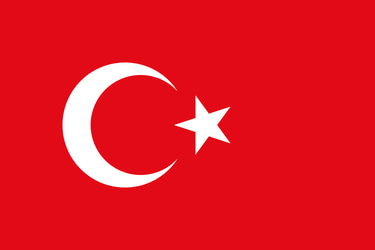Become TURKISH
IT’S TIME TO
AUTHENTIC TURKISH LIVING
Explore the vibrant city of Istanbul, the NEW COOL, and the rich culture of Türkiye, its delicious cuisine and unique traditions.

DIVE INTO A LIFESTYLE
From its foundation by the Turks and the rise of the Seljuk and Ottoman Empires, Türkiye has played a pivotal role in world history. Its rich cultural tapestry reflects influences from the Byzantine, Persian, and Arab civilizations, blended with deeply rooted Turkic traditions. With its stunning architectural heritage, from ancient ruins like Ephesus to majestic Ottoman palaces and mosques, TÜRKİYE offers a timeless journey through its dynamic and enduring cultural legacy.
After the establishment of the Republic of Türkiye in 1923, the country underwent a remarkable transformation. Under the leadership of Mustafa Kemal Atatürk, it embraced modernization, secularism, and economic reforms, positioning itself as a key player between Europe and Asia. Today, Türkiye’s thriving arts scene, expanding tourism industry, and advancements in technology and education highlight a nation that honors its past while shaping a bright future. A cultural bridge between East and West, Türkiye is celebrated for its unique language, cuisine, and spirit of resilience.
We have created a selection of words and expressions that you won’t find in any textbook or course, helping you understand Turkish words that carry deeper cultural meanings while expanding your knowledge of the country and its history.


EXPAND YOUR KNOWLEDGE
If you are interested in learning more about Turkish culture and history as well as the language, we recommend that you download our complete Turkish language course!
You will not only receive all the contents available on our website in convenient pdf formats but also additional contents, including bonus vocabulary, more grammar structures and exclusive cultural insights with additional Turkish vocabulary that you won't in any other textbook.
The additional articles include over 100 unique words and expressions related to the culture of the Turkish people. Not only will you be able to speak the Turkish language with confidence but you will amaze your listeners thanks to your knowledge of their country and history.
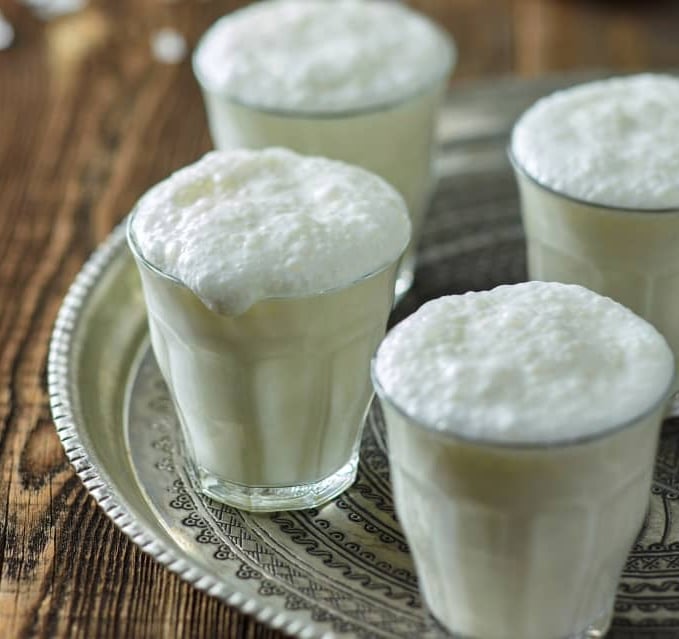

AYRAN
Ayran is one of the most iconic and beloved drinks in Turkish cuisine, known for its refreshing taste and simple ingredients. This traditional beverage is made from yoğurt (yogurt), su (water), and a pinch of tuz (salt), mixed together until smooth and frothy. Ayran is more than just a drink; it’s a cultural symbol that reflects the simplicity and richness of Türk mutfağı (Turkish cuisine). Found all over Turkey, from street food stalls to high-end restaurants, ayran is often served alongside dishes like kebap (kebab), lahmacun (Turkish-style meat flatbread), and pilav (rice pilaf), as it balances spicy and savory flavors perfectly.
One of the reasons ayran remains so popular is its ability to cool and hydrate, especially during the hot summer months. It’s not uncommon to see locals drinking it with lunch or dinner, or even grabbing a cold bottle from a bakkal (corner shop) while on the go. In rural areas and traditional homes, ayran is sometimes prepared by hand using a yayık (churn) to give it a thicker, creamier texture. There are even machines in restaurants called ayran makinesi (ayran machine) that keep the drink cold and frothy, ready to pour.
In addition to its taste, ayran is also valued for its health benefits. Because it’s made from yoğurt, it contains probiotics that aid digestion and support gut health. The combination of su and tuz also makes it excellent for rehydration, especially after eating ızgara (grilled meat) or spending time in the sun.
In recent years, ayran has gained attention beyond Turkey as a natural and healthy alternative to sugary soft drinks. While some people may find its salty flavor surprising at first, it quickly becomes a favorite for those who enjoy a savory twist to their beverages!


BADEMCİK
During holidays and special occasions like bayram (festival/holiday), roasted or sugar-coated bademcik is often served to guests alongside çay (tea) or kahve (coffee), symbolizing hospitality and abundance. In Turkish markets and aktar (spice shops), you'll find various types of bademcik—raw, roasted, salted, or covered in chocolate—making it a versatile and much-loved ingredient in Turkish food culture.
In Turkish cuisine, bademcik (almond) holds a special place not only as a nutritious snack but also as an ingredient in many traditional dishes and sweets. Known for its mild, buttery flavor and health benefits, bademcik is used in both sweet and savory recipes across different regions of Turkey. One of the most beloved uses of bademcik is in şekerleme (confectionery), especially in badem ezmesi (almond paste), which is a soft, smooth treat often enjoyed with Turkish coffee. In cities like Edirne, badem ezmesi is a regional specialty, typically made from finely ground bademcik, şeker (sugar), and a touch of gül suyu (rose water) for a fragrant finish.
Another popular appearance of bademcik is in tatlılar (desserts). Whole or sliced bademcik is often used to decorate baklava (layered pastry with nuts and syrup), şekerpare (soft semolina cookies soaked in syrup), and revani (semolina cake). It adds both texture and a rich, nutty taste to these already indulgent sweets. In sütlaç (rice pudding) or aşure (Noah’s pudding), toasted bademcik enhances the overall flavor and provides a visual appeal that’s hard to resist.
In savory cooking, bademcik is used in some regional rice dishes and etli yemekler (meat dishes), where it offers a pleasant crunch and a subtle sweetness. For instance, in some versions of iç pilav (stuffed rice), chopped or slivered bademcik is sautéed with pirinç (rice), kuşüzümü (currants), and tarçın (cinnamon) to create a richly flavored stuffing for poultry or vegetables.


BAKLAVA
Baklava is one of the most famous and beloved desserts in Turkish cuisine, known for its rich flavor, delicate texture, and intricate preparation. Made from layers of thin yufka (phyllo dough), baklava is typically filled with finely chopped ceviz (walnut) or fıstık (pistachio), then baked until golden and crispy. After baking, it is soaked in şerbet (sugar syrup) made from şeker (sugar), su (water), and a hint of limon suyu (lemon juice), giving it a moist, sweet finish. The balance between crunchy layers and syrupy richness is what makes baklava an unforgettable treat.
Different regions of Turkey have their own versions of baklava, each with unique touches. In Gaziantep, considered the heart of baklava production, the dessert is made with premium Antep fıstığı (Gaziantep pistachios) and clarified tereyağı (butter), giving it a distinctive flavor and aroma. In other areas, like the Black Sea region, baklava is often made with ceviz, offering a slightly more rustic and hearty version. Some families even prepare ev yapımı baklava (homemade baklava) during religious holidays like Bayram (festive holiday), where it plays a central role in hospitality and celebration.
Traditionally, baklava is cut into elegant shapes such as dilim (slice), kare (square), or elmas (diamond), and is served in small portions due to its richness. It’s often enjoyed with a glass of çay (tea) or kahve (coffee) after a meal or during special occasions. In some settings, kaymak (clotted cream) or a scoop of dondurma (ice cream) may be added on the side to make the experience even more indulgent.
The process of making baklava requires patience and skill. The yufka (phyllo dough) must be rolled out incredibly thin, almost transparent, and carefully layered with tereyağı (butter) brushed between each sheet. Once filled and baked, the hot şerbet (sugar syrup) is poured over the cooled pastry to ensure the perfect absorption without making it soggy.


BEREKET
Bereket (abundance, blessing) is a deeply rooted concept in Turkish culture, representing more than just material wealth—it embodies the idea of spiritual richness, harmony, and gratitude for what one has. Traditionally, bereket is associated with food, harvest, family, and even daily life. When someone says, “sofrada bereket var” (there is abundance at the table), they are not only referring to the quantity of food, but also to the shared joy, unity, and generosity that accompany a meal. In Turkish households, bereket is seen as something that increases when shared, especially during iftar (evening meal during Ramadan) or bayram (holiday) celebrations.
The belief in bereket is deeply intertwined with Turkish hospitality. Offering ekmek (bread) and su (water) to a guest, even if nothing else is available, is believed to bring bereket into the home. In rural köyler (villages), farmers often say a short dua (prayer) before planting or harvesting crops, asking for toprakta bereket (abundance in the soil). Similarly, shopkeepers might hang a small sign or charm in their stores that says “Allah bereket versin” (May God grant abundance), hoping for good fortune in their business dealings.
Symbols of bereket are also found in Turkish art and tradition. For example, the nar (pomegranate) is commonly used as a symbol of fertility and prosperity. Breaking a nar at weddings or on New Year’s Eve is thought to bring şans (luck) and bolluk (plenty) in the coming year. Likewise, many homes and shops display nazar boncuğu (evil eye bead) to protect the bereket they believe they have, shielding it from jealousy or negative energy.
The idea of bereket extends to language and everyday expressions. When someone finishes a meal, it’s customary to say “ellerinize sağlık” (health to your hands) to the cook, recognizing their effort and, in turn, spreading a sense of bereket. In business, people wish each other “bol kazançlar” (plentiful earnings) as a way of expressing goodwill and hope for mutual success.
BERE
Bere (knitted cap) is a common and culturally meaningful item of clothing in Turkey, especially during the colder months. Worn by people of all ages, a bere serves not only a practical purpose—keeping the head warm—but also expresses personal style and, at times, regional identity. In rural parts of Turkey, hand-knitted bereler (caps) made from wool are still quite common, often crafted by family members during long winter evenings. These traditional bereler are often colorful and may feature simple patterns, showing both creativity and a sense of community.
In cities, bere has become a staple winter accessory, especially in regions where kış (winter) brings cold winds and rain. You’ll see people wearing bere while walking through the busy streets of İstanbul, waiting for otobüs (bus) or enjoying a cup of çay (tea) at a corner kafeterya (cafeteria). Whether paired with a mont (coat) or a casual kazak (sweater), a bere completes the outfit and provides comfort during chilly weather.
The word bere is also used in Turkish military and police settings, where different colored bereler represent different roles or units. For example, a bordo bere (maroon beret) is famously worn by elite commandos in the Turkish Armed Forces, symbolizing discipline, strength, and prestige. In this context, the bere becomes more than just an accessory—it holds symbolic and institutional importance.
The bere also appears in Turkish idioms and expressions. For example, the phrase "bere takmak" (to wear a cap) might be used literally or symbolically to refer to preparing for harsh conditions or adapting to a new situation.


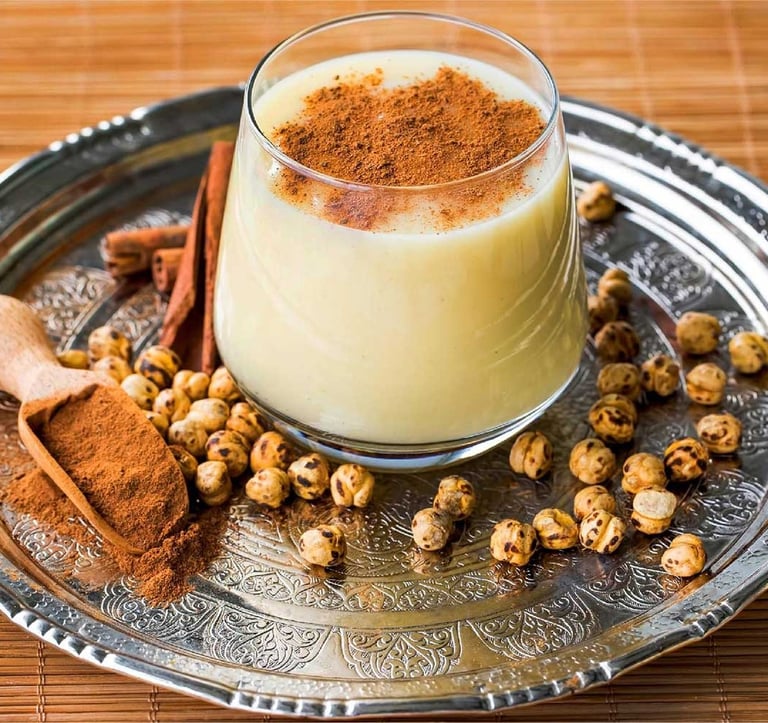

BOZA
Boza is one of the oldest and most traditional fermented beverages in Turkish cuisine, with a history that dates back to the early Turkic tribes of Central Asia. Thick, slightly sour, and lightly sweet, boza is typically made from darı (millet), su (water), and şeker (sugar), and goes through a natural fermentation process that gives it its unique taste and probiotic qualities. In modern Turkey, boza is mostly consumed during the kış (winter) months and is especially popular in cities like İstanbul and Ankara.
Traditionally, boza is served cold in a glass and topped with a generous sprinkle of tarçın (cinnamon) and a few roasted leblebi (chickpeas), creating a delightful contrast of flavors and textures. It is thick enough to eat with a spoon, making it more of a snack than a drink. In Turkish homes, boza is often associated with warmth, nostalgia, and family gatherings. Many people recall their grandparents serving boza on winter nights, often paired with stories from the past and long conversations over the soba (wood stove).
The preparation of boza requires time and care. The darı is first boiled until soft, then blended and fermented for a couple of days in a warm environment. As it ferments, the mixture thickens and develops its characteristic tangy flavor. Because of its fermentation, boza is rich in probiyotik (probiotic) content, which makes it beneficial for digestion and overall gut health. It’s also high in carbohydrates, offering a quick source of energy, which is why it was historically favored by soldiers and workers during the Osmanlı Dönemi (Ottoman period).
Today, boza is still produced both commercially and at home. Some families take pride in their own ev yapımı boza (homemade boza) recipes, often passed down through generations. In some Turkish neighborhoods, you can still hear the traditional bozacı (boza seller) shouting their signature calls “Bozaaa!” late on cold evenings.
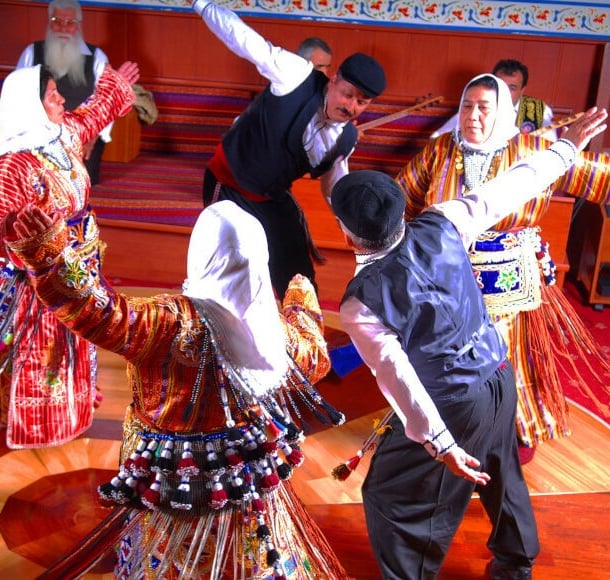

CEM
A cem (gathering or ritual ceremony) is a central spiritual practice in the Alevi tradition, which is a distinct religious and cultural community within Turkey. Unlike the more commonly known namaz (Islamic prayer), the cem is a communal ritual that combines elements of prayer, music, poetry, and shared reflection. It is usually held in a cemevi (Alevi house of worship) rather than a cami (mosque), reflecting the unique beliefs and practices of the Alevi community.
The cem is led by a dede (spiritual leader), who guides the ceremony, offers teachings, and facilitates the rituals. The participants, known as canlar (souls, people of the path), sit in a circle, symbolizing equality and the absence of hierarchy. Music plays a vital role in the cem, particularly the use of the saz (stringed instrument) to accompany sacred hymns called deyiş (religious poems or songs). These hymns often include the words of Alevi saints and poets such as Yunus Emre or Pir Sultan Abdal, and convey messages of divine love, human dignity, and spiritual longing.
One of the most symbolic elements of the cem is the semah (ritual dance), a graceful, circular movement performed by men and women together. The semah is not merely a dance, but a physical expression of the soul’s journey toward unity with the divine. As the canlar perform the semah, they turn in harmony, reflecting the idea of the universe in motion and the human connection to creation.
During a cem, participants may also engage in acts of ikrar (spiritual commitment), niyaz (offering or respectful greeting), and lokma paylaşımı (sharing of sacred food). The shared food, or lokma (blessed meal), is an important part of the ritual, symbolizing unity, gratitude, and mutual support among the community.


CEZVE
A cezve (small coffee pot) is an essential item in every Turkish kitchen, used specifically for preparing Türk kahvesi (Turkish coffee), one of the most beloved and time-honored beverages in Turkish culture. Traditionally made from bakır (copper), although modern versions can also be found in çelik (steel) or even seramik (ceramic), the cezve has a long handle and a small pouring lip, designed to brew coffee over low heat.
To make authentic Türk kahvesi, finely ground kahve (coffee) is mixed with su (water) and, depending on preference, şeker (sugar) in the cezve. The mixture is slowly heated, often over a köz (ember) or low flame, without stirring after the initial mix. As the coffee heats up, it forms a thick köpük (foam) on top, which is carefully distributed into the cups before the rest of the coffee is poured. This foam is a sign of well-prepared coffee and is highly valued by those who serve and drink it. A good cezve helps preserve the temperature and ensures an even brewing process that brings out the strong, aromatic flavor of the coffee.
The act of serving Türk kahvesi in a traditional setting often includes a small fincan (demitasse cup), a glass of su (water), and sometimes a piece of lokum (Turkish delight). When hosting guests, offering coffee prepared in a cezve is considered a gesture of misafirperverlik (hospitality), and it’s not uncommon to hear the phrase “Bir fincan kahvenin kırk yıl hatırı vardır” (A cup of coffee is remembered for forty years), emphasizing the importance of kindness and sharing.
The cezve also plays a symbolic role in important life moments. In traditional kız isteme (bride request) ceremonies, the prospective bride prepares coffee for the groom and his family using a cezve, sometimes adding tuz (salt) instead of sugar as a playful test of the groom’s patience and manners


ÇEŞME
A çeşme (fountain) is a common and culturally significant structure in Turkish towns, cities, and villages, traditionally built to provide clean su (water) for public use. More than just a source of hydration, the çeşme is a symbol of generosity, community, and devotion in Turkish history. Many çeşmeler (fountains) were commissioned as acts of hayır (charitable deed), often by vakıf (endowment) foundations or prominent individuals who wanted to serve the public and gain spiritual merit. You can find çeşmeler built into the walls of mosques, standing freely in public squares, or tucked away in narrow streets, often ornately decorated with mermer (marble) and Ottoman calligraphy.
Historically, the construction of a çeşme was not only a practical solution for water distribution but also a reflection of mimari (architecture) and aesthetic values of the time. During the Osmanlı Dönemi (Ottoman period), especially in cities like İstanbul, many elaborate çeşmeler were built with artistic details such as kitabe (inscription panels), floral motifs, and elegant domed structures. These fountains were often inscribed with poetic verses or religious dedications, connecting the act of providing water with spiritual beliefs.
In villages and rural köyler (villages), the çeşme often serves as a social gathering spot. Locals meet there to fill testi (earthenware jugs), wash hands, or simply exchange greetings. It becomes a part of everyday rhythm, especially in places where running water inside homes may still be limited. In older times, marriage proposals or important announcements were sometimes made near the köy çeşmesi (village fountain), making it a focal point of communal life.
While piped water systems have largely replaced the functional role of çeşmeler, many still remain as historical landmarks or are maintained for their symbolic value. Some neighborhoods even keep their çeşme operational, especially during yaz (summer), as a gesture of hospitality toward passersby or travelers.


KAŞIK HAVASI
Çeyiz (dowry) is a deeply rooted tradition in Turkish culture, representing the gifts, textiles, and household items prepared by a bride and her family before marriage. The çeyiz is not only a collection of practical goods but also a symbolic expression of care, effort, and family pride. It typically includes handmade dantel (lace), yatak örtüsü (bedspread), havlu (towel), yorgan (quilt), and çarşaf (bed sheet), many of which are embroidered with delicate designs and made over the course of several years. Mothers and grandmothers often begin preparing the çeyiz when a daughter is still very young, using traditional nakış (embroidery) techniques passed down through generations.
The çeyiz is displayed during a special event called çeyiz serme (laying out the dowry), which takes place before the düğün (wedding). Friends, neighbors, and relatives gather to admire the bride’s belongings, often praising the quality of the work and the family’s dedication. This event strengthens social bonds and reinforces the communal nature of marriage traditions in Turkey. In some regions, the çeyiz sandığı (dowry chest), usually made of wood and often beautifully decorated, is carried ceremoniously from the bride’s home to the groom’s house, sometimes accompanied by music and celebration.
While the contents of a çeyiz can vary based on regional customs and family resources, common items also include mutfak eşyaları (kitchen utensils), tabak (plates), çatal bıçak takımı (cutlery set), and sometimes even elektrikli ev aletleri (household appliances). These items help the couple start their new life together and symbolize the bride’s contribution to the home. In modern times, although lifestyles have changed and some aspects of the tradition have become more simplified, the emotional and cultural value of the çeyiz remains strong.


DERVİŞ
Derviş is a deeply spiritual figure in Turkish and Islamic culture, representing a person who has chosen a life of asceticism, devotion, and simplicity in pursuit of divine truth. The word derviş (dervish) comes from Persian origins, but it became widely associated with tasavvuf (Sufism), the mystical dimension of Islam. Dervişler (plural of derviş) are often members of various tarikat (Sufi orders), such as the Mevlevî Tarikatı (Mevlevi Order), which was founded by followers of the famous poet and mystic Mevlânâ Celâleddîn-i Rûmî. These individuals renounce material possessions and dedicate themselves to a path of inner purification, spiritual discipline, and connection with the hakikat (truth) of existence.
A central part of a derviş’s life is the practice of zikir (remembrance of God), which can be either silent or vocal, and is meant to keep the divine constantly in one's heart and mind. In the Mevlevi tradition, the sema (whirling ceremony) is a particularly striking spiritual practice, where dervişler perform a graceful, meditative dance, spinning in circles to symbolize the rotation of the planets around the sun and the soul's journey toward unity with the divine. Their distinctive long white robes, tall felt hats (sikke), and the powerful music of the ney (reed flute) all contribute to a deeply moving experience for both practitioners and observers.
The derviş is also often seen as a figure of wisdom and humility. Unlike scholars or clergy who may focus on the external aspects of religion, the derviş seeks batınî bilgi (esoteric knowledge)—a deeper, inward understanding of faith. Through çile (spiritual struggle or trial), they undergo phases of hardship and solitude, believing that suffering can bring one closer to God. Many dervişler live in tekkeler (Sufi lodges), which historically served as centers of learning, hospitality, and worship. In Ottoman times, tekkeler were vital spiritual hubs, and the derviş was a respected figure in both rural and urban communities.
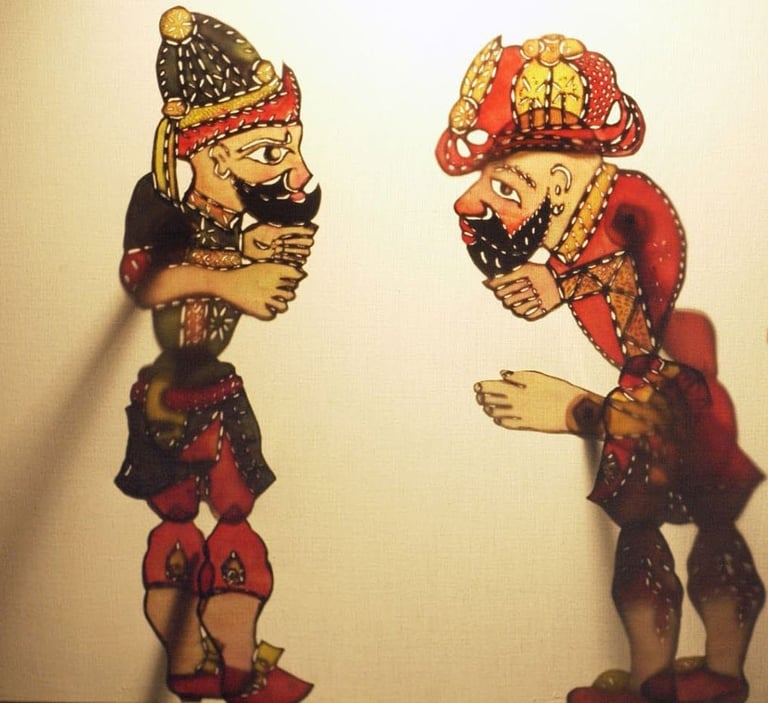

KARAGÖZ
Karagöz is one of the most iconic characters in traditional Turkish gölge oyunu (shadow play), a form of entertainment that dates back to the Ottoman period. Named after its main character, Karagöz (literally "black eye"), this theatrical tradition pairs him with his witty and sharp-tongued friend Hacivat, creating a humorous and satirical dynamic that has delighted audiences for centuries. The play is performed using deriden yapılmış figürler (figures made of leather), which are held up against a white curtain and illuminated from behind to cast their shadows, bringing the story to life.
Karagöz represents the voice of the common people—direct, unfiltered, and often crude. He speaks in everyday language, reacts impulsively, and frequently misunderstands Hacivat’s more sophisticated and poetic speech. Hacivat, on the other hand, symbolizes the educated elite and tries to act with refinement and adab (etiquette). The humorous misunderstandings and playful arguments between the two often serve as a form of toplumsal eleştiri (social criticism), poking fun at bureaucracy, social classes, and cultural norms.
A traditional Karagöz oyunu (Karagöz play) includes several standard sections: the mukaddime (introduction), the muhavere (dialogue) between Karagöz and Hacivat, the fasıl (main scene), which might include various characters from different regions and ethnicities of the Ottoman Empire, and finally the bitiş (ending). Other characters—like Tiryaki (the opium addict), Kastamonulu (man from Kastamonu), or Zenne (female character)—add color and diversity to the storyline, often reflecting the multicultural makeup of Ottoman society.
Karagöz plays were especially popular during Ramazan (Ramadan), when families would gather in courtyards or coffeehouses after iftar (the evening meal to break the fast) to enjoy the performance. The hayalî (puppeteer) was a highly skilled artist who controlled all the characters and voiced them using different tones, while accompanying the scenes with şarkılar (songs) and efektler (sound effects).


DÖNER
Döner is one of the most iconic and beloved dishes in Turkish cuisine, known not only in Turkey but also around the world. The word döner (rotating) comes from the Turkish verb dönmek (to turn), referring to the way the meat is cooked—on a vertical spit that slowly rotates in front of a heat source. Traditionally made from marinated kuzu eti (lamb meat), döner can also be prepared with dana eti (beef) or tavuk (chicken), depending on regional preferences and modern variations. The thinly sliced meat is typically served in several formats, making it a versatile street food and fast-food favorite.
One popular version is döner ekmek (döner sandwich), where slices of meat are stuffed into a piece of somun ekmeği (round bread) along with domates (tomato), salatalık turşusu (pickled cucumber), soğan (onion), and a drizzle of yoğurtlu sos (yogurt-based sauce) or acı sos (spicy sauce). Another common variation is dürüm döner (wrap-style döner), where the meat and toppings are wrapped in lavaş (thin flatbread), making it easy to eat on the go. In more formal settings, you might find pilav üstü döner (döner over rice), a plate where döner is served atop a bed of buttery pirinç pilavı (rice pilaf), often accompanied by grilled vegetables and a spoonful of yogurt.
What makes döner truly special is the marinade and the cooking method. The meat is typically seasoned with a blend of baharatlar (spices) such as kimyon (cumin), karabiber (black pepper), kekik (oregano), and sometimes yoğurt (yogurt) or soğan suyu (onion juice) to tenderize and flavor it deeply. As the outer layer of the meat cooks, it is shaved off with a long knife, ensuring that each serving is hot, juicy, and flavorful.
Döner has also become a cultural symbol, representing the fusion of tradition and modernity in Turkish food. In many countries, especially in Europe, döner or kebab shops run by Turkish immigrants have popularized this dish as an affordable and delicious fast food. Today, döner is not only a quick meal but also a source of national pride and an ambassador of Turkish culinary heritage.


EVLİYA
Evliya is a term used in Turkish to describe a person regarded as a veli (saint or friend of God) in Islamic tradition. The word evliya is actually the plural of veli, but in Turkish, it is often used as a singular noun as well, especially when referring to renowned spiritual figures. An evliya is someone believed to possess deep takva (piety), hikmet (wisdom), and a close, almost mystical relationship with the divine. These individuals are respected not only for their knowledge of Islam but also for their exemplary character, humility, and miraculous deeds, known as keramet (miracles).
In Turkish history and folklore, evliyalar are often linked with tasavvuf (Sufism) and are considered spiritual guides who dedicate their lives to the service of God and humanity. They are remembered for their acts of iyilik (kindness), sabır (patience), and adalet (justice), and many are associated with specific regions or towns, where they are believed to have lived, taught, or performed miracles. These places often become sites of türbe (tomb) visitation, where people come to pray, seek blessings, or simply show respect.
One of the most famous figures bearing this title is Evliya Çelebi, a 17th-century Ottoman traveler, writer, and historian. Although not a saint in the traditional religious sense, his name includes “Evliya” as a mark of respect and perhaps spiritual aura. His monumental work, the Seyahatnâme (Book of Travels), is a treasure trove of historical, cultural, and social information, documenting his journeys across the Ottoman Empire and beyond. Evliya Çelebi combined keen observation with vivid storytelling, making him a legendary figure in Turkish literature and historiography.
Evliyalar are also significant in rural Turkish culture, where they often become central figures in halk inancı (folk belief). Many believe that an evliya’s ruh (spirit) continues to watch over the land, protect communities, and help those in need. On certain days, people may visit their tombs to make dua (prayers), offer adak (vows or offerings), and ask for healing or guidance.


EXPAND YOUR KNOWLEDGE
If you are interested in learning more about Turkish culture and history as well as the language, we recommend that you download our complete Turkish language course!
You will not only receive all the contents available on our website in convenient pdf formats but also additional contents, including bonus vocabulary, more grammar structures and exclusive cultural insights with additional Turkish vocabulary that you won't in any other textbook.
The additional articles include over 100 unique words and expressions related to the culture of the Turkish people. Not only will you be able to speak the Turkish language with confidence but you will amaze your listeners thanks to your knowledge of their country and history.
